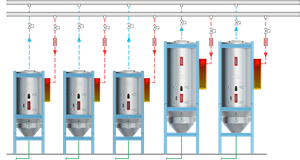Thrifty California Processor Dries PET with 'Waste' Heat
Processor strategies: FDS Manufacturing Co.
Southern California can be a challenging environment for manufacturers, not least because of concerns about the cost and availability of electrical power.
Southern California can be a challenging environment for manufacturers, not least because of concerns about the cost and availability of electrical power. It was a series of brownouts around 10 years ago that got FDS Manufacturing Co. in Pomona thinking about backup diesel generators. But those units can be run only for 500 hr per year, owing to air-emissions rules. It was when FDS installed a 6-in., 4000-lb/hr PET sheet extrusion line with associated crystallizer and dryer a few years ago that the firm began looking
into electrical cogeneration with gas turbines to control energy costs.
“There’s 800 amps for that extruder alone,” says Kevin Stevenson, v.p. of engineering. “But the light bulb really lit up when I realized that the thermal output of a gas turbine—separate from the electrical output—was a perfect match for the Btu requirements of a 4000-lb/hr PET crystallizer or dryer.” That led him to try something that, as far as he knows, has never been done before.
BREAKING NEW GROUND
FDS (fdsmfg.com) is a family-owned firm that was started by Stevenson’s grandfather in 1950 and is run today by his father. It has grown to about $20 million in annual sales to local agricultural markets, producing thermoformed PET fruit trays and clamshell berry boxes, as well as injection molded PP berry baskets and corrugated cardboard rolls, sheets, and pads. It employs around 200 people and operates one extrusion line, six thermoformers, and 12 molding presses of 50 to 300 tons in 250,000 ft² of manufacturing and warehouse space in Pomona, plus another facility in Fowler, Calif.
When he began thinking of gas-turbine power, Stevenson got help from Regatta Solutions in San Juan Capistrano (regattait.com), which is the exclusive distributor in Southern California for Capstone
Turbine Corp. (capstoneturbine.com) in Chatsworth, Calif. Steve Acevedo, Regatta’s president and CEO, says a number of local manufacturers have been taking advantage of the low price of clean-burning natural gas to cut electrical costs and ensure reliable power—an issue that has been highlighted by an
indefinite shutdown of the San Onofre nuclear power generating plant. Despite the high cost of electricity in Southern California, Acevedo recommends that a gas turbine installation be sized for the thermal needs—heating or cooling—of the plant. “There’s your economic justification,” says Acevedo. “The electrical power cogeneration is the icing on the cake.”
For FDS, that “icing” provides about 30% of the Pomona plant’s electrical needs, saving about $30,000 a month. “Average electrical cost here is 16¢/kWh, and we’re cogenerating for 10¢/kWh,” Stevenson says.
In 2008, FDS installed six Capstone turbines of 65-kW capacity each (which cost around $150,000 apiece at today’s prices). The waste heat from four of those turbines passes through an air/water heat exchanger to provide cold process water at 42 to 47 F by means of a salt-solution absorption cooling system. Waste heat from the other two turbines is sent through an air/air heat exchanger to provide all the hot air for an XTLR-4000 crystallizer and 450-ft3 DHD-120 drying hopper, both from Universal Dynamics, Inc., Woodbridge, Va. (unadyn.com). The conversion was achieved with UnaDyn’s assistance. FDS left the original gas burners on this equipment, in case they were ever needed. But they have been running on waste heat 24/7 for three years without a hitch. Stevenson thinks this has never been done before, and UnaDyn sources agree.
Related Content
Extrusion Excellence: This Year's Top Stories
Revisit the year’s most popular articles on extrusion technology and processes, showcasing innovations, best practices, and the trends that captured the plastics processing community’s attention.
Read MoreHow to Effectively Reduce Costs with Smart Auxiliaries Technology
As drying, blending and conveying technologies grow more sophisticated, they offer processors great opportunities to reduce cost through better energy efficiency, smaller equipment footprints, reduced scrap and quicker changeovers. Increased throughput and better utilization of primary processing equipment and manpower are the results.
Read MoreBrewer Chooses Quick-Change Flexibility to Blow Wide Range of PET Beer Bottles
Beermaster Brewery found a “universal” stretch-blow machine from PET Technologies enables multiple changes per day among four sizes of beer bottles.
Read MoreWhat You Need to Know About Roll-Cooling Design
Cooling rolls might not look like high-tech machines, but the fact is there is a surprising amount of technology involved in their design, manufacture and use. Here’s what you need to know.
Read MoreRead Next
Lead the Conversation, Change the Conversation
Coverage of single-use plastics can be both misleading and demoralizing. Here are 10 tips for changing the perception of the plastics industry at your company and in your community.
Read MoreBeyond Prototypes: 8 Ways the Plastics Industry Is Using 3D Printing
Plastics processors are finding applications for 3D printing around the plant and across the supply chain. Here are 8 examples to look for at NPE2024.
Read MoreSee Recyclers Close the Loop on Trade Show Production Scrap at NPE2024
A collaboration between show organizer PLASTICS, recycler CPR and size reduction experts WEIMA and Conair recovered and recycled all production scrap at NPE2024.
Read More












